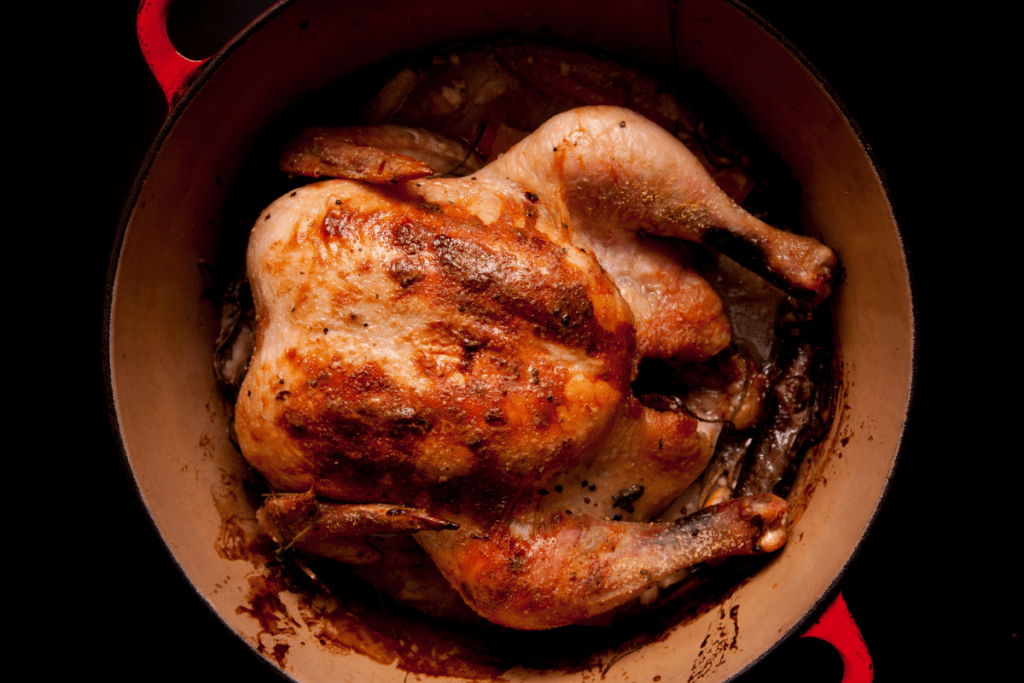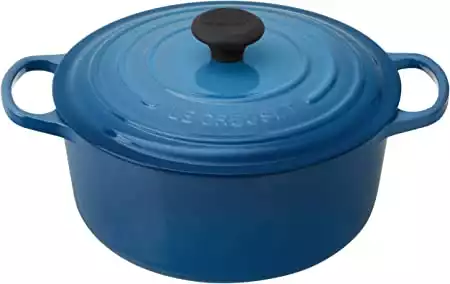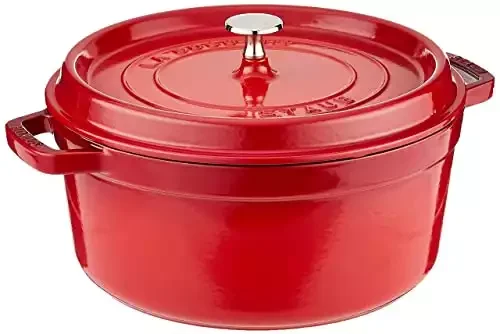Le Creuset and Staub make some of the best-enameled cast iron cookware available. Their Dutch Ovens and Cocottes are incredibly versatile and can easily last for several generations.
In this Staub vs. Le Creuset comparison, we’ll look at the key features and differences of each brand. By the end, you will be able to tell which pot excels in different situations and what option is best for your cooking needs.
In This Article
Review: Le Creuset Marseille Signature Round Dutch Oven
Le Creuset is an historic cookware brand. Beginning in 1925, Le Creuset pioneered the production of enameled cast iron cookware. They still operate out of the original foundry in Fresnoy le Grand, France, and have become the gold standard for enameled cast iron.
Le Creuset is most known for its brightly colored line of enameled cast iron cookware, but they also produce stoneware, stainless steel, and nonstick items.
The enamel-coated Le Creuset Dutch oven is their most iconic piece. It has industry-leading heat retention and distribution, and its glass-enamel coating is very hard-wearing. You will frequently find pieces being passed down as family heirlooms, a testament to their craftsmanship and durability.
Le Creuset’s primary line of dutch ovens are available in an oval or round shape and come in a wide range of sizes. On top of those, they make specialty and seasonal shapes and sizes.
Review: Staub Cast Iron Round Cocette
Staub is another premium cookware brand that specializes in enameled cast iron cookware. Staub was founded in 1974 in Alsace, France. Their production still remains in France but has moved to Merville.
Staub has been around for about half as long as Le Creuset, but their products are made with equally high standards and attention to detail.
The Cocotte (koh-kot), as Staub calls it, is the company’s most popular and widely used item. In most English speaking countries around the world, these dishes are known as casseroles. In the US we generally call them Dutch ovens, and in France cocotte is typical. Staub decided to use the French name in all markets, and “cocotte” is actually molded into the lids of their pieces.
Staubs cocottes are primarily round, with a handful of ovals available. They also offer various specialty and seasonal shapes and sizes.
Head to Head Comparison: Staub Vs Le Creuset
While both brands produce several products, in this article we’ll focus on the Le Creuset round dutch oven and Staub round Cocotte. This is the most common shape and is offered in the widest range of sizes. Each brand also makes mini, wide, and deep models which are not included in this comparison.
Sizing
Le Creuset offers nine different sizes of Dutch oven. That makes it relatively easy to find the right one depending on how many people you regularly cook.
Similarly, Staub makes eight options all in similar size increments. Again, that’s plenty of choices for most cooking applications.
Both brands make a mini, wide, and deep model as well. All three are good for specific tasks, but don’t excel as an everyday cooking vessel.
The minis are good for serving sauces or individual desserts, but don’t make sense for most cooking tasks. The wide pot can be good for extra large cuts of meat and also for reducing liquids and sauces quickly. The deep models can slow the loss of liquids and make great soup pots.
Le Creuset Round Dutch Oven Sizing:
| Capacity in Quarts | Approximate Servings | Height in Inches | Diameter in inches | Weight in lbs w/lid |
|---|---|---|---|---|
| 1 | 1-2 | 3.5 | 6.75 | 3.8 |
| 2 | 1-2 | 3.5 | 7.25 | 5.4 |
| 2.75 | 1-2 | 3 | 8.75 | 7.8 |
| 3.5 | 3-4 | 4 | 8.75 | 8.4 |
| 4.5 | 3-4 | 4.5 | 9.5 | 9.6 |
| 5.5 | 5-6 | 4.5 | 10.25 | 11.25 |
| 7.25 | 7-8 | 5 | 11 | 12.8 |
| 9 | 9+ | 5 | 12.25 | 16.6 |
| 13.25 | 9+ | 6 | 16.5 | 21.3 |
Staub Round Cocette Sizing:
| Capacity in Quarts | Approximate Servings | Height in Inches W/O Lid | Diameter in Inches | Weight in lbs w/lid |
|---|---|---|---|---|
| 1.25 | 1-2 | 3.2 | 6.3 | 5.2 |
| 2.75 | 2-3 | 3.9 | 8.7 | 8.7 |
| 4 | 3-4 | 4.1 | 9.5 | 10.1 |
| 5.5 | 5-6 | 4.7 | 10.3 | 12.6 |
| 5.5 | 5-6 | 4.7 | 10.3 | 12.6 |
| 6 | 5-6 | 6.1 | 11 | 15.4 |
| 7 | 6-7 | 6.2 | 11 | 15.2 |
| 8.75 | 8-9 | 5.5 | 11.8 | 17.7 |
| 13.25 | 9+ | 6.5 | 13.4 | 23.7 |
Remember that the number of servings listed above is approximate and depends on what you are making and who you are having over for dinner.

Winner: Le Creuset
You can easily find a size that fits your needs from either brand. The Le Creuset dutch oven does offer one more size than Staub and for that reason, they take this round, but only by a hair.
Weight
Cast iron cookware is inherently heavy. One of its most desirable features is just how dense and heavy the material is. In cooking, that translates to even heat distribution and retention.
The cookware from both of these brands are going to be heavy, and that’s not a bad thing. Le Creuset cookware is by no means light, but in the enameled cast iron category, they make some of the lightest cookware available.

Winner: Le Creuset
When comparing equivalent sizes, Le Creuset comes in at 1-2 pounds lighter than Staub. That’s significant weight savings, especially if you’re lifting and carrying one of the larger sized pieces.
Enamel
So far the features have been pretty similar, but this is where one of the biggest differences comes in. The enamel that each brand uses in their Dutch ovens and cocottes are quite different.
The Le Creuset dutch oven uses a glass enamel that is a glossy, light sand-color on the interior of their Dutch ovens. The enamel coating is completely smooth and totally encases and protects the cast iron within.
The impermeable nature of the coating means that you don’t have to worry about any ingredients reacting with the cast iron core. There’s no problem cooking tomatoes or any other acidic ingredients, and it’s ok to store or marinate foods for extended periods of time.
The smooth cooking surface of the Le Creuset dutch oven helps with food release and makes cleaning any stuck-on debris easy. If anything does get really stuck on these pots, it’s no problem to soak them with soapy water for a couple of hours or even overnight.
The glass enamel is also very durable. While metal utensils can be used, they can leave visible marks on the light-colored interior. The markings won’t affect the performance of the Dutch oven and can generally be removed with a thorough cleaning.
Le Creuset’s sand-colored cooking surface also allows you to easily monitor your cooking. Checking for browning, stuck-on food particles, and the like. The easy monitoring and hard-wearing nature, make this style of enamel easy to care for and perfect for daily use.
Staub on the other hand utilizes a matte black enamel cooking surface. The black enamel has an appearance like raw cast iron, but it is a coating that also completely encases the cast iron core.
Rather than a completely smooth cooking surface, the black enamel is slightly textured. This was designed to excel with high heat cooking and searing in particular.
The black enamel is also incredibly durable and won’t show any markings from metal utensils. That is a plus for appearances, but monitoring food while cooking is more difficult as a result. If you do get food stuck or burnt on to the cocotte, soaking in soapy water is usually all you need.
If you cook a lot of meat and a hard sear is what you’re after, that is where the black enamel really excels.

Winner: Le Creuset
The enamel cooking surface on Staub and Le Creuset do an equally good job protecting the cast iron core and are durable enough to last for generations.
The black enamel may be able to produce a slightly better sear, but the smooth, sandy interior of Le Creuset also does an adequate job in that regard. Being able to clearly see what’s going on in the bottom of the pot is what puts Le Creuset ahead in this category.
Colors
Color is what set Le Creuset apart from its competition in 1925, and Staub followed suit 50 years later. The unique colors are the first thing you notice when you see a Le Creuset dutch oven or Staub cocotte. Some even consider this to be just as important as the cookware’s functionality.
For those that have a hard time deciding between a large number of options, Staub has made things a little easier. They currently offer 10 different colors, with some sizes available in fewer than that. They use high-quality pigments that won’t fade and they only occasionally introduce and/or discontinue their colors.
If you’re a collector and get a thrill from owning hard-to-find pieces then look to Le Creuset. They currently have 24 different color options and are known to do collaborations and limited edition pieces. They do have a small base of colors that are not likely to change soon (or ever), but they release and discontinue colors regularly.

Winner: Staub
Easy to disagree here, but the simple and solid line of colors offered by Staub is best suited for this style of cookware. The color pigments used by both brands are of equally high quality, but I like a line of colors that will stick around as long as the cookware will.
Lids
The lids offered by each brand feature their unique enamel coating. Le Creuset with glossy sand enamel and Staub with matte black.
Le Creuset’s lids are a classic dome shape that fit very securely and don’t allow for much steam or heat escape. Historically, these lids came with a black phenolic knob and could handle oven temperatures up to 500 F. This has recently been changed, and most of their Dutch ovens come with the stainless steel knob as standard. Le Creuset says that the stainless steel knobs are safe at any oven temperature, but their dutch ovens are only rated to 500 F.
Staub uses a unique looking lid that is flat across the top with a raised edge around the perimeter. The inside of the lid features small rounded spikes that evenly distribute condensation back on to the food being cooked
The knobs on the Staub lids are made from nickel steel and are rated for oven use up to 500 F. That is plenty hot for most applications, but the base of their cocottes are actually oven safe up to 900 F!

Winner: Staub
The lid of the Staub Cocotte is unique among today’s offerings, but they have a timeless design. They are modeled after some of the earliest Dutch ovens, which had sunken lids that could hold hot coals for cooking and baking. The self-basting lids are a nice functional addition.
Handles
Both brands feature handles that are cast along with the rest of the pot as a single piece of iron. You don’t have to worry that these handles are ever going to fall off.
Le Creuset designed their handles to be large, rounded, and easy to grab. They are wide enough that you can get your entire hand around them even while wearing a thick oven mitt.
Staubs handles are more rectangular in shape and don’t stick out as much. They are big enough to get a decent grip in most scenarios but less secure if using a very thick mitt.

Winner: Le Creuset
The larger sized handles give you a lot of confidence regardless of what kind of towel or hot pad you may be using. A sturdy grip is very important when dealing with hot food and such a heavy piece of equipment.
Affordability
Le Creuset and Staub are both luxury brands and they are among the most expensive options available. Even if you are paying a slight premium for the brand name, both options are built to last and have exceptional fit and finish.
Le Creuset is generally priced slightly higher than staub and you can usually plan on spending over $300 for a mid-sized Dutch oven.
While Staub is often a little bit less expensive, you can still count on spending over $200 for a mid-sized cocotte.

Winner: Staub
Neither option is cheap, and both are built to the highest standards. So, if you can get one for a good chunk of change less, I would say that’s a pretty good deal.
My Recommendations
Both of these brands make some of, if not the best-enameled cast iron cookware on the market. They are also both luxury brands and the price tags reflect that. Apart from dutch ovens, you’ll find that Le Creuset also makes one of the best enameled cast iron skillets available.
Most people would likely be happy with either choice but some key differences make each more useful in different situations.
Choose Le Creuset if:
- You will be making a wide variety of dishes
- You want a wide range of colors to choose from or collect
- You want a more secure grip when carrying your Dutch oven
- It’s important to visually monitor your food while cooking
Choose Staub if:
- You will be cooking a lot of meat
- You don’t want to worry about scratches and marks in your pot
- You want to cook at temperatures above 500F









